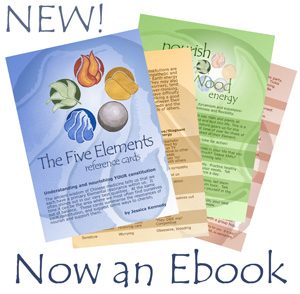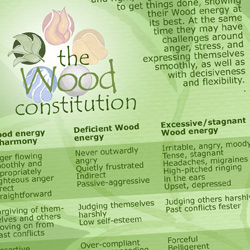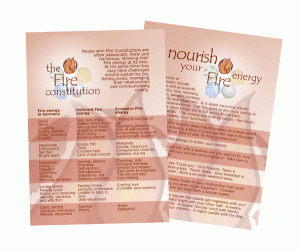 If your acupuncturist is practising Five Element Acupuncture, they will be keen to diagnose your Constitutional Element. This Constitutional Factor, often abbreviated to ‘CF’, gives insight into who you are at your core.
If your acupuncturist is practising Five Element Acupuncture, they will be keen to diagnose your Constitutional Element. This Constitutional Factor, often abbreviated to ‘CF’, gives insight into who you are at your core.
No matter that your Spleen and Earth have been knocked off balance by your diet, or your Lungs and Metal are reeling from an attack by an External Pathogen, underlying all that, your Constitutional Factor is more fundamental.
It’s likely to imbue you with your greatest strengths, and the things people love most about you, as well as your notable weaknesses and tendencies to imbalance. You Constitutional Element is likely to be the one, in the list above, where you sit least frequently in the ‘In Balance’ column, and most often find yourself at one or other end of the spectrum.
Adventures in self diagnosis
So then it may be tempting, and it may even be accurate on occasion, to self-diagnose.
Ah yes, you may think as you read one of the Elements, that definitely sounds like me.
And I did this myself as an acupuncture student, and bamboozled the acupuncturist I was seeing as a patient, into treating me as an Earth Constitution, for a year or so. Before we realised that, while I had imbalances there, that wasn’t the answer. We switched to another Element, and much more profound change took place, across all my Elements, which is one of the hallmarks of successful constitutional treatment.
We are not always in hurry to see ourselves completely clearly.
Sometimes it’s a journey
With some people, their Constitutional Element is obvious the moment they walk through the door.
But, it’s not always that straightforward. It can become a process, even for a skilled practitioner, to figure out your Element. Sometimes after a few treatments it becomes clear that together you’re engaged in asking your body a series of questions, and listening to the answers.
Perhaps a significant imbalance in one Element starts to clear as a result of your first few treatments, and it becomes clearer what is more central and what is more transient.
Colour, sound, odour, emotion
What are the tools your acupuncturist uses to diagnose you constitutionally?
They’ll be listening to you closely, and not only to what you say, but to what you don’t say, and how you say it all, and they’ll be observing you closely. The four pillars of Five Element diagnosis are your colour, sound, odour and emotion.
Your colour
Each Element can generate specific colours across parts of your face (no matter what your ethnicity).
Are your cheeks ashen or florid? Is the darkness under your eyes more blue or more greenish-brown? Does your flesh have a yellowish tint throughout?
Your sound
You may not think of your voice as shouting, laughing, singing, crying or groaning, but it may be a neater fit into one of these categories than you realise…
Your odour
And I’m afraid, yes, your acupuncturist may be smelling you. You yourself, that is, not your toiletries. As you walk into the room, or after you take off some clothing, or as you lie on the couch.
You may have noticed yourself that family members may have a distinctive smell. Babies of course are famous for smelling gorgeous, but some adults smell wonderful too. And if your natural odour is not great, Chinese medicine sees that very much as a sign of imbalance.
The categories for this don’t all sound very pretty – rancid, scorched, fragrant, putrid and rotten – but each has a healthy and a less healthy manifestation. An unhealthy ‘fragrant’ smell, for example, can be unpleasantly sickly. A healthy ‘rancid’ smell, is like the wonderful smell of freshly cut grass.
Emotion
How smoothly does your anger flow? Is your grief stuck? How readily can you truly take in sympathy or reassurance?
When you recount a life experience that had a big impact, what emotion has stuck with you the most – the grief or the fear? The resentment or the pain of feeling unloved?
Together these signs are pointers, to what lies more under the surface, of your body, mind and spirit.
Confirming by asking your body
And the proof of the pudding is successful response to treatment. Asking your body the question, and listening to the answer.
Confirmation of your constitutional diagnosis comes through seeing your beautiful response when the right Element is addresssed. It can be an amazing pleasure to behold.
Buy my lovely reference cards and subscribe to my newsletter to find out more…
 It’s taken a while, but the Five Elements Reference Cards are finally available as an Ebook.
It’s taken a while, but the Five Elements Reference Cards are finally available as an Ebook.
 People often ask me how to find a good acupuncturist in their area.
People often ask me how to find a good acupuncturist in their area. If reading these cards leads you to think that your Liver may be Stagnant, your Heart Qi may be Deficient, or your Kidneys may be out of balance, this doesn’t mean there is cause for alarm.
If reading these cards leads you to think that your Liver may be Stagnant, your Heart Qi may be Deficient, or your Kidneys may be out of balance, this doesn’t mean there is cause for alarm. If your acupuncturist is practising Five Element Acupuncture, they will be keen to diagnose your Constitutional Element. This Constitutional Factor, often abbreviated to ‘CF’, gives insight into who you are at your core.
If your acupuncturist is practising Five Element Acupuncture, they will be keen to diagnose your Constitutional Element. This Constitutional Factor, often abbreviated to ‘CF’, gives insight into who you are at your core. A cycle, in motion
A cycle, in motion Deficiency or excess?
Deficiency or excess?